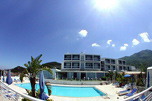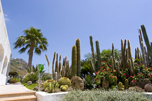Description
A forest of chestnut trees, holm oaks, strawberry trees and heather; the spring of "Buceto"; one of the biggest craters on the island-the Fonda Ferraro; a splendid view of the Castello Aragonese and the Gulf of Naples.This area is the municipality of Barano d'Ischia; of the four "Lizard Trails" established by the muni cipality, this is the most interesting at the naturali stic level as it surrounds one of the many volcanic craters that shaped this beautiful Campanian island. Tilis trail begins with the departure Bar Nik. One must follow via Cretaio. One can take a shorter route by following the old mule track with terraced steps. After going uphill for a stretch of the path, the road begins to level at the 'Croce dei castagni (The Cross of the Chestnuts) which is atRanch Aragona Near a notice board there is a terraced trail that leads, toward the left, into a thick, chestnut vegetation. One then climbs up toward the cultivated terraces which are still well kept and supported by massive, stone walls. Once one leaves the agricultural wne of Cava, Bianca, the trail proceeds in the direction toward Buceto as it clambers up on the slopes of Monte Trippodi and passes through thick woods of ch~ stnut trees and holm-oaks. As one continues climbing, to the left one ~ note a pit that is half underground; this was an old ice-house that was used up to a few decades ago to keep snow in it that would then serve as ice to preserve food during warmer periods. A little further ahead one will arrive at an known as San Paolo, a wide basin that wailrea one time cultivated and has been natural~e~ agam today. Here the trail changes direction and sudden] drops into a narrow, deep valley invaded by a~ exuberant vegetation of bramble, smilax the intricate honeysuckle; this vegetation covers the crags of an old crater. At this point one an;. ves at the spring of Buceto from which once was drawn sap carried by an aqueduct of the 16th century; one will notice, further ahead, at the edge of the trail, the corroded pipes in the rock. At the end of the trail one ends up again on via Cretaio, one continues along toward the left over the stretch of the trail in asphalt. After passing the Chiesa del Crocifisso, erected in 1731, one arrives at a bifurcation, right in front of the Maddalena wood.One then proceeds to bend around a secondary road to the right, and continues along a lane (remembering always to keep to the right); by looking up one will notice that the old Ferraro crater is being skirted, its shape still quite recognizable. Straight ahead stands the volcanic dome of Posta Lubrano, interwoven with cultivated land. While still keeping to the trail, one passes next to the Cantina del Sergente, a refreshment stop created in a traditional, Ischitan cellar. The return back to Fiaiano takes place only after one treats oneself to a beautiful view of thecastello Aragonese on the green fiaiano pinewood which extends out toward the sea along a route outlined by the last lava flow of 1302.
Info
Follow the red lizard
Duration: 2,15 hours ca.
Difficulty:**
Departure: Fiaiano-BarNik
Arrival: Fiaiano-Piazzetta
Path: Fiaiano, Marecoppo, Monte Trippodi, Buceto, Carusiello, Cretaio, Fondo Ferraro, Casa Arcamone, Bosco dei Conti, Fiaiano.
Difference: 220 meters uphill.
Coordinates Gps of Flaiano:
40°43’47’’N- 13°55’56’’E.
Where to eat: at cantina del Sargente, via Fondo Ferraro, Tel. 081901372-3406157362.
Bus lines: line 6











